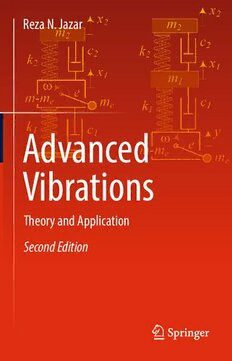Table Of ContentReza N. Jazar
Advanced
Vibrations
Theory and Application
Second Edition
Advanced Vibrations
Reza N. Jazar
Advanced Vibrations
Theory and Application
Second Edition
RezaN.Jazar
SchoolofEngineering
RMITUniversity
Melbourne,VIC,Australia
SchoolofCivilEngineering
andArchitecture
XiamenUniversityofTechnology
Xiamen,Fuzhou,China
ISBN978-3-031-16355-5 ISBN978-3-031-16356-2 (eBook)
https://doi.org/10.1007/978-3-031-16356-2
1stedition:©SpringerScience+BusinessMediaNewYork2013
2ndedition:©TheEditor(s)(ifapplicable)andTheAuthor(s),underexclusivelicensetoSpringerNature
SwitzerlandAG2022
Thisworkissubjecttocopyright.AllrightsaresolelyandexclusivelylicensedbythePublisher,whether
thewholeorpartofthematerialisconcerned,specificallytherightsoftranslation,reprinting,reuse
ofillustrations,recitation,broadcasting,reproductiononmicrofilmsorinanyotherphysicalway,and
transmissionorinformationstorageandretrieval,electronicadaptation,computersoftware,orbysimilar
ordissimilarmethodologynowknownorhereafterdeveloped.
Theuseofgeneraldescriptivenames,registerednames,trademarks,servicemarks,etc.inthispublication
doesnotimply,evenintheabsenceofaspecificstatement,thatsuchnamesareexemptfromtherelevant
protectivelawsandregulationsandthereforefreeforgeneraluse.
Thepublisher,theauthors,andtheeditorsaresafetoassumethattheadviceandinformationinthisbook
arebelievedtobetrueandaccurateatthedateofpublication.Neitherthepublishernortheauthorsor
theeditorsgiveawarranty,expressedorimplied,withrespecttothematerialcontainedhereinorforany
errorsoromissionsthatmayhavebeenmade.Thepublisherremainsneutralwithregardtojurisdictional
claimsinpublishedmapsandinstitutionalaffiliations.
ThisSpringerimprintispublishedbytheregisteredcompanySpringerNatureSwitzerlandAG
Theregisteredcompanyaddressis:Gewerbestrasse11,6330Cham,Switzerland
Donottrustanysciencethatjustifiesbutfails
topredict.
to:
Kavosh
Vazan
Mojgan
Preface
For several years, my students complained that the available books in the market
on the topic of vibrations are all treating this science inconsistent from different
viewpoints. They were asking me to write a book on vibrations that covers all
important and must-known subjects deep enough; shows applications well, has
enough examples, right to the point; and prepare them to tackle real engineering
problemsaswellasmakethemreadyforthenextstepinnonlinearvibrationsand
vibrationsofcontinuoussystems.Thisbookispreparedtoaddressthoserequests.It
isamodified,improved,andupdatedversionoftheAdvancedVibrations:AModern
Approachthatispublishedin2013.Thepresentbookhasaneducationaldivisionof
chapters,sections,andsubsectionsthatmakeittobemoreappropriatefortraditional
classroomteaching.
This book is for designers, practicing engineers, and students of engineering.
It introduces the fundamental knowledge used in mechanical vibrations. This
knowledgecanbeutilizedtodevelopcomputerprogramsforanalyzing,designing,
and optimizing vibration problems in industrial systems.The main problem in the
study of vibrations is to determine the motion of a system subjected to a given
excitation. The excitation and the response can be expressed by either kinematic
quantitiessuchasdisplacements,velocities,andaccelerations,orbyforces.
Thesubjectofvibrations hasbeen intheengineering curriculumformorethan
hundred years. I consider the 1896 Lord Rayleigh’s (John William Strutt, 3rd
BaronRayleigh,aBritishscientist)"TheoryofSound"asthefirstmodernbookon
the subject of sound, wave propagation, and vibrations. However, the first books
on vibrations with a mechanical engineering viewpoint appeared as "Vibration
Problems in Engineering" (1928) by the father of modern engineering mechanics,
theRussian-Americanengineer,StephenP.Timoshenko(1878–1972),andthenas
“Mechanical Vibrations” (1934) by the Dutch-American engineer, Jacob P. Den
Hartog.AlthoughTimoshenkowasthearchitectofmodernstructureofengineering
educationandhisvariousbookswereusedforalongtimeineducatingmechanical
and civil engineers, it was Den Hartog’s Mechanical Vibrations that was globally
accepted as a classical educational book. Almost all mechanical vibration books
that appeared after 1940 follow the structure of Den Hartog’s, starting from time
ix
x Preface
responseandendingwithfrequencyresponseanalysisandoptimization.Sometimes
aglanceatrandomvibrations,nonlinearvibrations,continuoussystems,vibrations
control,ormodalanalysismayalsobeseeninvariousbooks.Thecurrentbookalso
follows the same order as Den Hartog’s. It begins with a review of fundamental
concepts of mechanical vibrations and continues with time response, and ends
withfrequencyresponses.Aglanceonmusicfromvibrationsviewpoint,first-order
vibrating systems, vibration absorber design, and root mean square optimization
methodaresometopicsthatsolelyappearinthisbook.
Level ofthe Book
This book has evolved from nearly three decades of research and working on real
engineering vibrating systems, and teaching courses in fundamental and advanced
vibrations.Itisprimarilydesignedtoteachthelastyearofanundergraduatestudy
and/or the first year of graduate study in engineering. Hence, it is an intermediate
textbook. It provides the reader with both fundamental and advanced topics. The
whole book can be covered in two successive courses; however, it is possible to
jumpoversomesectionsandcoverthebookinonecourse.Studentsarerequiredto
knowthefundamentalsofkinematicsanddynamics,aswellasabasicknowledge
oflinearalgebra,differentialequations,andnumericalmethods.
The contents of the book have been kept at a fairly theoretical-practical level.
Many concepts are deeply explained and their application emphasized, and most
of the related theories and formal proofs have been explained. The book places a
strong emphasis on the physical meaning and applications of the concepts. Topics
thathavebeenselectedareofhighinterestinthefield.Anattempthasbeenmade
toexposestudentstoabroadrangeoftopicsandapproaches.
An asterisk (cid:2) indicates a more advanced topic which is not designed for
undergraduateteachingandcanbedroppedinthefirstreading.
Organizationofthe Book
The text is organized such that it can be used for teaching or for self-study. It is
organizedin3parts:
Part I, “Vibration Fundamentals,” introduces the vibrations as a cause of trans-
formationofenergy.Itcoverskinematicsofvibrationsanddevelopspracticalskills
toderivetheequationsofmotionofvibratingsystems.TheconceptsoftheNewton-
Euler dynamics and Lagrangian method are both used equally for the derivation
ofequationsofmotion.PartIalsocoversallmathematicalanalysisthatthereader
needstoabsorbtheadvancedtopicsthroughoutthebook.
Part II, “Time Response,” covers the time and transient responses of vibrating
systemsandnon-harmonicexcitations,aswellasfreevibrations.
Preface xi
Part III, “Frequency Response,” covers the methods of developing the steady-
state frequency response of vibrating systems to harmonic excitations. The princi-
plesofvibrationoptimizationwillbeintroducedinthispart.Therootmeansquare
optimizationtechniqueforsuspensiondesignofmechanicalsystemsisintroduced
andapplied.Theoutcomeoftheoptimizationtechniqueistheoptimalstiffnessand
dampingforsuspendedequipment.
Method ofPresentation
Thestructureofpresentationisina“fact-reason-application”fashion.The“fact”is
themainsubjectweintroduceineachsection.Thenthereasonisgivenasa“proof.”
Finally,theapplicationofthefactisexaminedinsome“examples.”The“examples”
areaveryimportantpartofthebook.Theyshowhowtoimplementtheknowledge
introduced in “facts.” They also cover some other facts that are needed to expand
thesubject.
Prerequisites
Thebookiswrittenforseniorundergraduateandfirst-yeargraduate-levelstudents
inengineering.Theassumptionisthatusersarefamiliarwithmatrixalgebraaswell
asbasicdynamicsanddifferentialequations.Prerequisitesarethefundamentalsof
kinematics,dynamics,calculus,fundamentalsofdifferentialequations,andmatrix
theory.Thesetopicsareusuallytaughtinthefirstthreeundergraduateyears.
UnitSystem
Thesystemofunitsadoptedinthisbookis,unlessotherwisestated,theInternational
System of Units (SI). The units of degree (deg) or radian (rad) are utilized for
variablesrepresentingangularquantities.
Melbourne,VIC,Australia RezaN.Jazar
How to Use This Book
This book is suitable for the first course in vibrations and is written for a
full semester of 16 weeks long in graduate level. If the level of the course is
undergraduateormixed,andifthelengthofthesemesterisshorterthan16weeks,
then the following pattern can be suggested to fit the contents to different classes.
Teaching Chap. 3, Vibration Dynamic, is optional in all cases depending on the
background of students. The main topic of this chapter is to review dynamics and
remindstudentsoftheLagrangeanmethodofderivingequationsofmotion.Chapter
2mayalsobeleftforstudentstoreadbythemselves.
Undergraduate level, 10 or 12 weeks semester: Skip all asterisk sections and
teachthefollowingchapters.
IVibrationFundamentals
1VibrationKinematics
IITimeResponse
3OneDegreeofFreedom
IIIFrequencyResponse
6OneDegreeofFreedomSystems
7MultiDegreesofFreedomSystems
Undergraduatelevel,16weekssemester:Skipallasterisksectionsandteachthe
followingchapters.
IVibrationFundamentals
1VibrationKinematics
2VibrationDynamics
IITimeResponse
3OneDegreeofFreedom
4MultiDegreesofFreedom
5First-OrderSystems
IIIFrequencyResponse
xiii

